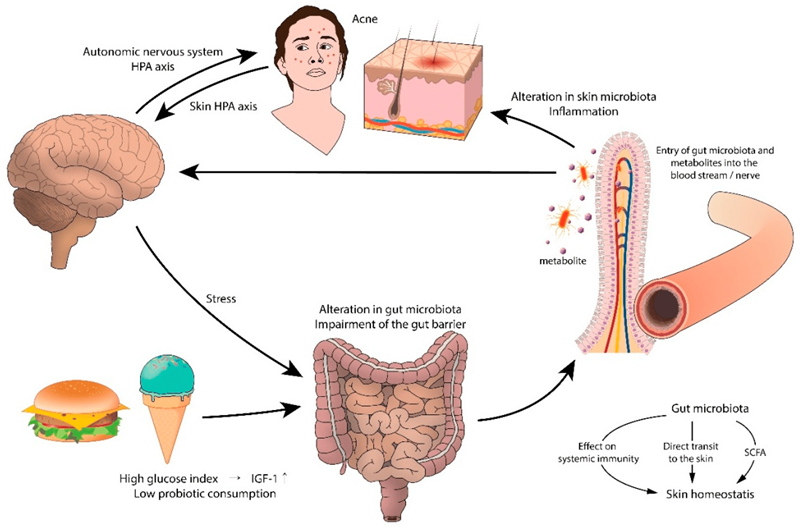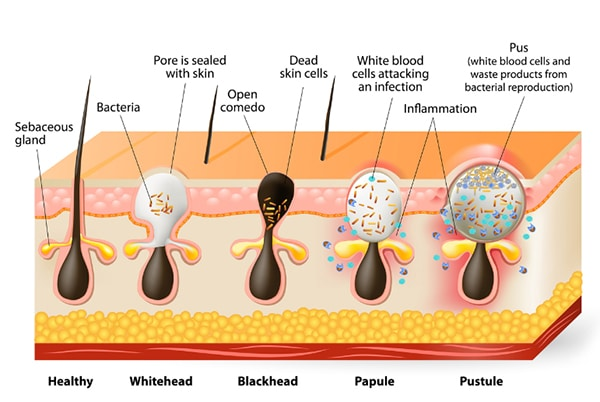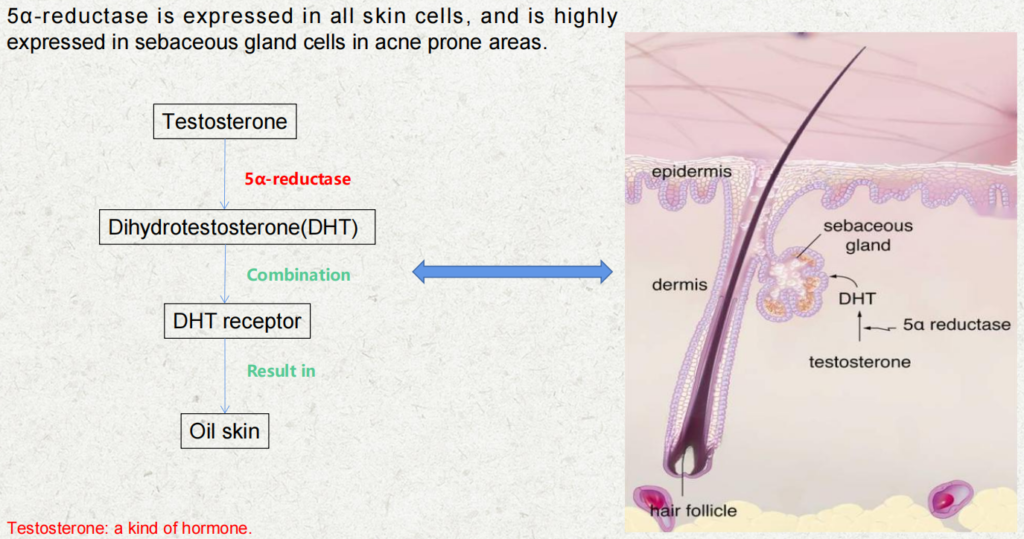In recent years, due to the influence of various factors, such as high stress, staying up, irregular work and rest, high-sugar diet, not only teenagers prone to acne, adults have also become a high incidence of acne. Especially after COVID-19, long-term wearing of masks is more likely to lead to frequent acne breakouts. How to effectively choose anti-acne raw materials is the key to good cosmetic formulations.

Acne, also known as “pimples”, is a chronic inflammation of the sebaceous glands of the hair follicles. It is caused by the blockage of hair follicles and sebaceous glands and the failure of sebum to escape normally. It is often found in the areas where the sebaceous glands are densely packed, and it will causes a variety of damages to the skin, such as pimples, acne, cysts and nodules.

Acne formation
Based on the mechanism of acne, we can control and slow down the symptoms of acne in the following ways:
- Cleansing- removing facial dirt and adherents;
- Exfoliation – correct keratinisation of the follicular ductal opening by dissolving or exfoliating the keratin;
- Antibacterial – inhibit the abnormal proliferation of Propionibacterium acnes;
- Anti-inflammatory- suppresses local inflammatory reactions in the skin;
- Skin repair – includes repairing the damaged barrier function of the skin, controlling the oil secretion of the skin, and maintaining the skin in a healthy state.
According to above ways, we’d like to share with you some anti-acne cosmetics raw materials.
- Anti-acne raw materials in cleansing
The accumulation of a large amount of oil secreted by sebaceous glands on the skin surface will not only clog the pores, but also provide propionibacterium acnes a suitable growth environment and aggravate the production of acne. Therefore, the acne skin needs to be properly cleaned to remove the excess oil, dander and microbial mixture on the skin surface.
The cleaning effect is mainly achieved through surfactants, such as soap-based cleansing products in the lauric acid, palmitic acid, stearic acid, etc.. Also including amino acid surface active: potassium cocoyl glycinate, sodium cocoyl glutamate, etc.; and cocamidopropyl betaine, sodium laureth sulfate, and so on.
- Anti-acne raw materials in oil-control
The main ways to reduce oil secretion are: inhibit the development of sebaceous glands, inhibit the maturation of sebaceous gland cells, reduce the number of active sebaceous glands; reduce the secretion of sebum through the inhibition of 5α-reductase.

Zinc PCA is a classic ingredient to inhibit 5α-reductase, thereby reducing the excessive secretion of sebum. However, it’s a chemical ingredient. Nowadays, consumers prefer natural products, so formulating natural oil-control ingredients in skincare products is a trend of the times. Plamed develop PMOil-control® 9574 and PMOil-control® Salicin-70. Both of them are extracted from plants, and are of high safety and potent effect; they can inhibit 5α-reductase and reduce Moreover, at a concentration of 1.0% PMOil-control® 9574’s oil control effect is better than “salicylic acid”, .”pyroglutamic acid”, “zinc PCA” 2-3 times.
- Anti-acne raw materials in anti-bacterial
Propionibacterium acnes is a gram-positive anaerobic bacterium that secretes proteins, esterases, lipopolysaccharides and other components. It is one of the most important causes of acne, so inhibiting it is important to anti-acne.
For example, Pionin (INCI name: Quaternium-73) has an extremely strong antibacterial activity with a strong inhibitory effect at low doses (0.008%). It inhibits the reproduction of bacteria on the surface of the skin and even sterilizes them. The wide range of antibacterial activity of pionin is not only strong for the skin fungus Malassezia, but also for fungal infections.
Matrine is extracted from the root of Sophora flavescenso. Study showed that it can inhibis the release of P. acnes and bacterial outer membrane vesicles. Additionally, it can inhibit a variety of bacilli, streptococcus b and Staphylococcus aureus in vitro to varying degrees, as well as a variety of dermatophytes. Thus, matrine can significantly treat acne and pimple.
- Anti-acne raw materials in anti-inflammation
Acne develops from small clogged whiteheads and blackheads to cystic nodules, because of the inflammatory response triggered in an anaerobic environment, so soothing anti-inflammatory ingredients need to be used when conditioning acne-prone skin.
For example, paeonol reduces the production and release of inflammatory mediators such as IL-6, IL-1β, and TNF-α. Portulaca oleracea extract significantly reduces the release of inflammatory mediators such as histamine H1 (HTH1), interleukin-31 (IL-31), protease-activated receptor-2 (PAR2), and capsaicin receptor protein (TRPV1) to produce anti-inflammatory activity. Dipotassium glycyrrhizinate can effectively reduce the secretion level of interleukin 1α (IL-1α) and interleukin 6 (IL-6). All of these three ingredients are natural anti-acne ones.
- Anti-acne raw materials in exfoliation
The most central element of acne formation is the formation of keratotic plugs, so it is one of the very important pathways to improve acne in terms of dissolution of keratotic plugs.
For example, Alpha Hydroxyl Acid can penetrate the surface layer of the skin, then dissolve the constituent substances between the keratin to accelerate exfoliation of the stratum corneum. Salicylic acid, a lipid-soluble substance in β-hydroxy acids, can quickly dissolve and strip off the waste impurities on the clogged pores. Also, it penetrates deeply into the inside of the pores to remove the sebum. Azelaic acid has the functions of anti-inflammation, inhibition of sebum secretion and regulates skin keratinisation, and also relieves post-inflammatory hyperpigmentation (PIH).
- Anti-acne raw materials in skin repair
During the occurrence and development of acne, the skin barrier will be damaged, so repairing the damaged skin barrier function plays an important role in preventing the recurrence of acne. It is an important physiological mechanism for the skin to resist exogenous stimulants and harmful substances.
Skin repairing active ingredients mainly are: ① hyaluronic acid can increase the water content of the stratum corneum. ② Ceramides can replenish the skin’s natural moisturizing factor. ③ Natural oils (green thorn fruit oil, olive fruit oil, avocado butter, etc.)can alleviate the skin’s sensitivity; ④ plant extracts, such as Centella Asiatica Extracts, Olea europaea Extracts, and others.
In conclusion, there are four main factors in the occurrence of acne: abnormal regulation of sebaceous glands by androgens, abnormal keratinization of sebaceous ducts, overgrowth of propionibacterium acnes and inflammatory immune reaction. In a anti-acne formulation, you should consider all above factors, then your formulation will work well. Above recommended anti-acne raw ingredients are good references for you. Formulating a right and effective anti-acne raw material is essential for skincare products.







